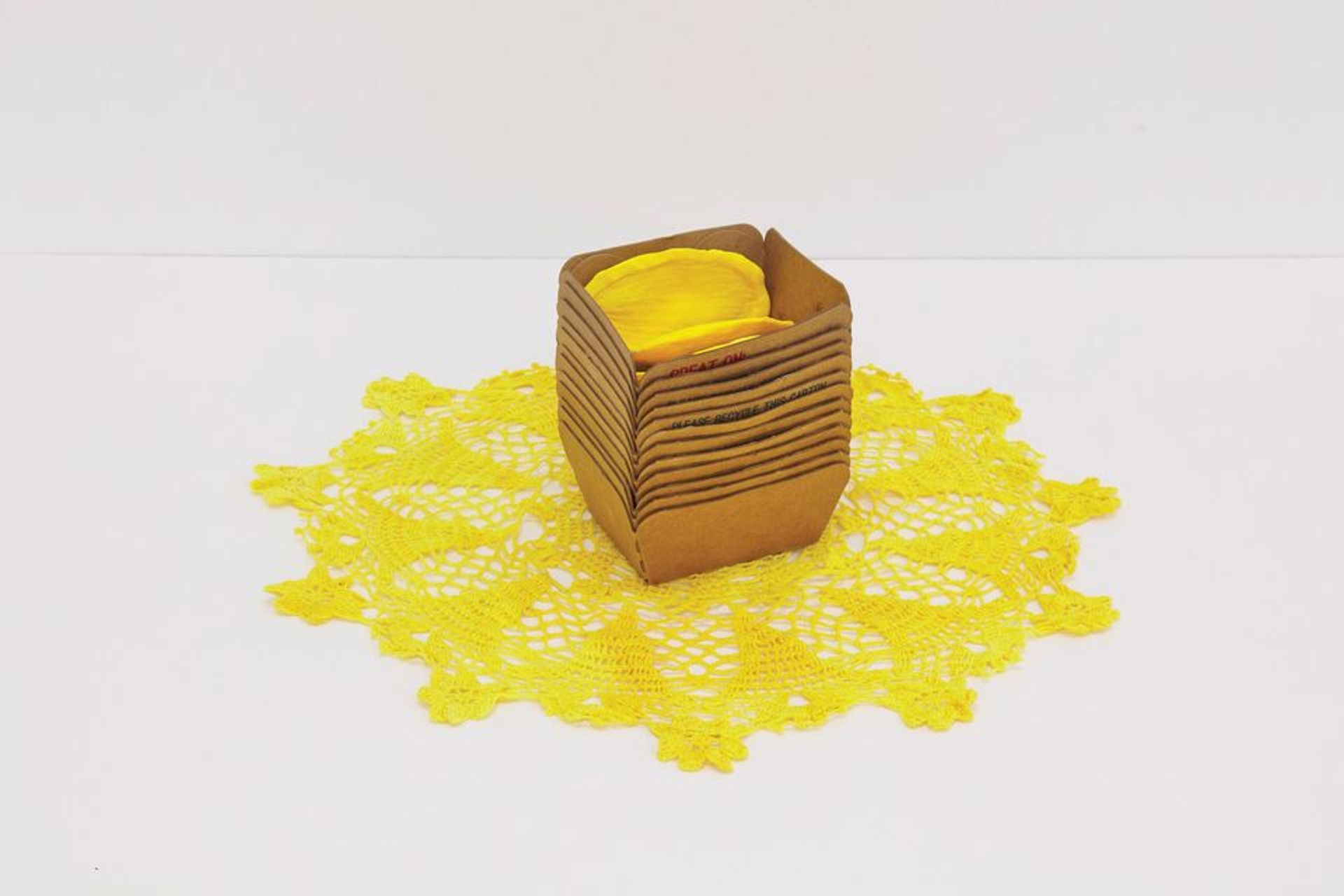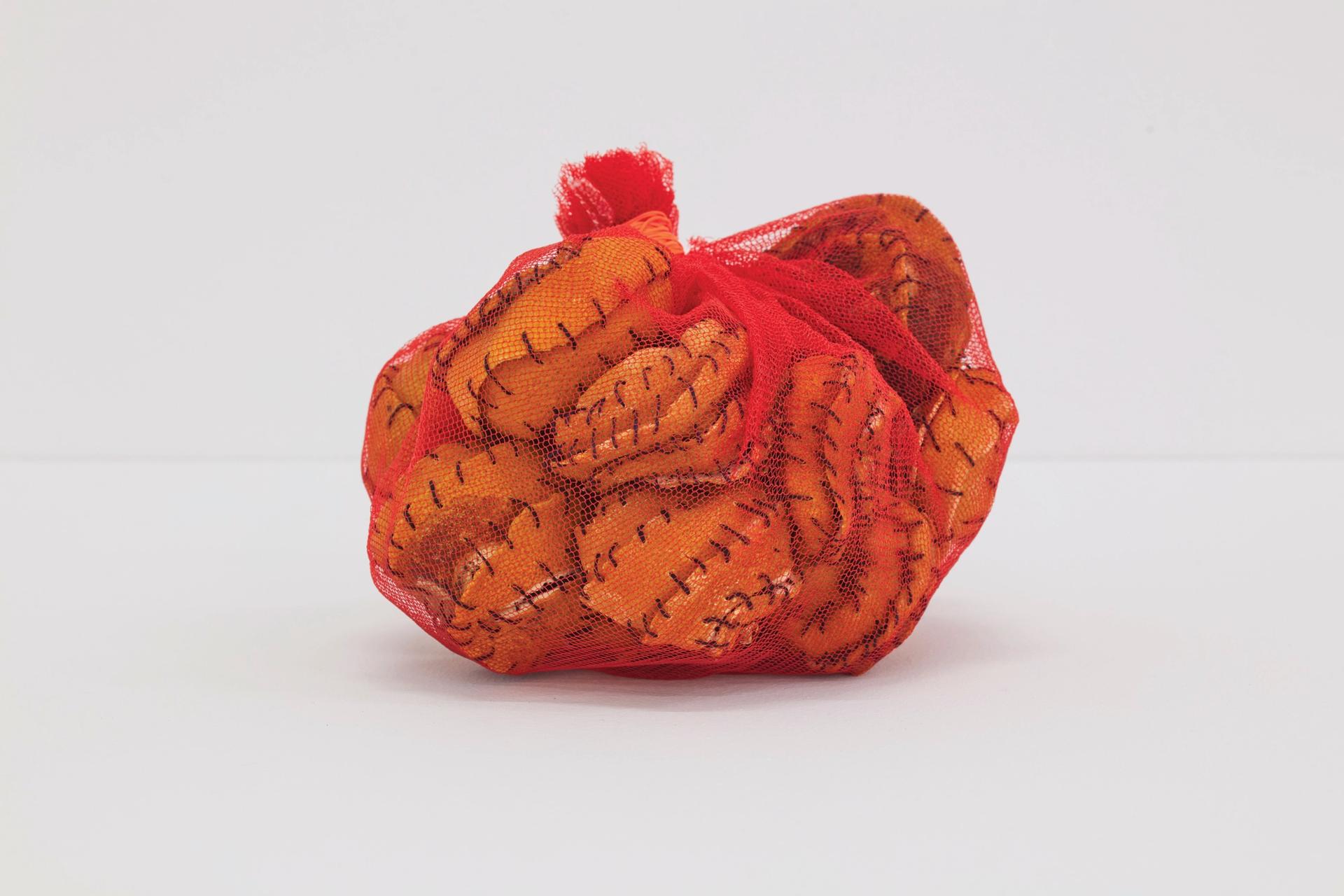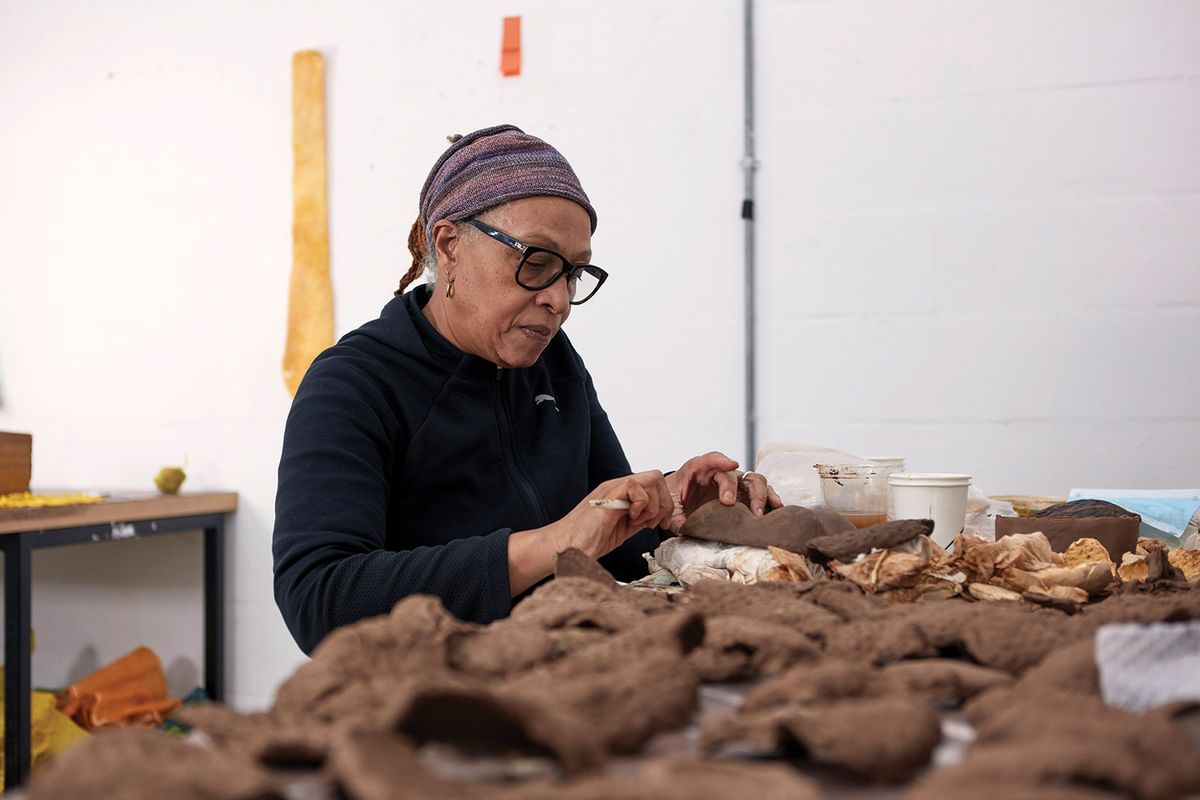Veronica Ryan was born in Plymouth on the Caribbean island of Montserrat in 1956, but her family moved to the UK when she was an infant. She now lives between Hertfordshire in the UK and New York. Her sculpture evades easy categorisation: it is non-figurative but associative, combining personal and cultural references while drawing on a wide variety of materials and techniques.
Over the years Ryan has worked with tropical fruit, feathers and dust, dyeing and embroidering a wide variety of fabrics, carving marble, stitching together fruit skins, casting in plaster, bronze and clay, crocheting fishing lines and arranging found and fabricated objects on industrial storage shelving. After a number of high-profile shows in the 1980s and early 1990s, she went off the art world radar—“I think there was a sense that making abstract work was not part of the programme” is her explanation—but now she is back with a vengeance.
Ryan’s solo exhibition Along a Spectrum at Spike Island, Bristol—originally due to open in February but postponed until May—is her most comprehensive yet and came about as a result of the Freelands Award, which enables an arts organisation to present an exhibition by a mid-career female artist who has not received the acclaim they deserve. She is also part of Portable Sculpture, at the Henry Moore Institute in Leeds, and has been commissioned to make work in response to Barbara Hepworth as part of The Hepworth Wakefield’s 10th anniversary celebrations this summer. Then, to coincide with Black History Month in October, Ryan will unveil a permanent public sculpture commissioned by Hackney Council in London to celebrate the Windrush Generation, the Caribbean people who settled in post-war Britain, now known mostly because of the scandalous treatment they have received by the British Conservative government.
The Art Newspaper: Most of the work in your Spike Island show was made during an on-site residency—to what extent did the direct context of Bristol influence the work?
Veronica Ryan: My first solo exhibition was at the Arnolfini in Bristol in 1987, and I can’t ignore the history: it’s very present. Walking along the river every day to Spike I was again reminded of Bristol’s big part in the Atlantic slave trade. I’d already been making work using tea bags and dying pillowcases with tea and then I discovered that the Spike Island building had been a tea packing factory so I went and studied the archives and that became a conversation in the work. In Bristol’s Georgian museum, once the home of sugar plantation and slave owner John Pinney, there’s more evidence of the merchant trading history and the whole culture of sugar leaving and coming into that port. The first chocolate Easter egg was produced by the Quakers in Bristol and one of the works I’m making is a cocoa pod that relates to thinking about trade routes and slave labour and the use of sugar with cocoa, and the millions of people dying in this attempt to create an unequal wealth. Then today you have this contemporary crisis of obesity that can be traced back to this past pillaging of cultures. So there are all these different connections with history and the current psychological trauma that people have inherited. At a certain point I had to detach a bit because you could just spend the whole time weeping.
Fruits, seeds, plants and vegetables have been a recurring theme in your work from the very beginning and they have a strong presence in this show.
They’ve just recently come back. There was a whole period when I got really anxious and didn’t make any work with a fruit or vegetable component. I felt that some of the earlier work was being seen as decorative and not very serious. It was not understood as a form of cultural enquiry: there’s a socio-political dimension that has always been in the work that was being missed. I’m also interested in exploring psychological dysfunctions and the way fruit and veg has this other, medical side that is about healing—mangoes have a lot of serotonin in them, for example, and my mother tells me that when she was pregnant with me she ate a lot of soursop, which has all these curative qualities, and which I use a lot in my work.
Why did you re-introduce this organic material back into the work?
Paula Cooper [Ryan’s dealer] came to the studio in New York a couple of years ago and she really responded to some seed works that I’d been making but not showing anyone. It was so liberating for me and seemed to unleash some kind of deep hurt. So now I don’t feel so inhibited. I’m interested both in seeds as a literal growing mechanism, but also the kinds of language around seeds as an idea, and even the medical use of radiation seeds. For Spike Island I’ve been making these long pouch-like structures by crocheting fishing line with seeds and fruit stones stacked inside them on the floor. I’m tying them up from the ceiling using the sailors’ knots I first came across on a residency in Cornwall which would have been used on the boats sailing across the Atlantic. These knots are very evocative: one I’m using is called a noose knot. Piecing together lots of different paradigms is the way I tend to work.

Ryan has worked with food containers since the 1990s; in Punnet I (2020), they sit on a crocheted doily and are filled with clay objects resembling mango stones © Max McClure; courtesy of the artist and Paula Cooper Gallery
At Spike Island you are casting in bronze, firing clay, sewing orange peel, crocheting fishing nets and more. What is the importance of this diversity?
I use all these different facets when they are needed in the work, which I see as the same equivalent to thinking about all the different discourses in the world. I’m engaged with thinking through the material. I’m seeing a breadth in these connecting parts—that’s much of the thinking around the crocheting and the fishing lines. The title of my exhibition and book is Along a Spectrum and I’m thinking about these different levels of realities or non-realities that we’re dealing with. That’s all part of the myriad materials I use.
You’ve also talked about the influence of ritual and votive objects from ancient and non-Western cultures.
When I was at the Slade I got permission to visit the British Museum stores where there were a lot of undocumented artefacts. I also spent a lot of time in the Egyptology department looking at objects made for the afterlife and looking at African art in terms of traditional cultures and how a lot of the artefacts were made in response to cultural systems and had specific meanings—and the way that one could convey equivalent meaning with different objects. Although I didn’t finish my MPhil at Soas [the School of Oriental and African Studies] I’m interested in archaeology and anthropology, thinking about early cultures and the creative ways that people have always needed to express themselves and I see my work as a continuation of that. There’s room for all these different kinds of discourses and I want to be able to define myself as the kind of artist I want to be, without people putting on labels. Now I’m thinking about making objects which are the manifestation of some kind of protection, making these kinds of votive bindings and structures as a way to find meaning and protection for oneself and to address all these continuing issues that surround us.
You were working in Bristol around the Black Lives Matter protests and the toppling of the statue of the slave trader Edward Colston. Is this also what you are referring to: making work that aspires to soothe as well as to express what is being experienced?
Yes, working as mending, and through the work finding ways to construct kinds of meaning, to be reparative, understanding these different realms of experience and putting the pieces together in a way that isn’t destroying oneself. I don’t know anyone who makes art for art’s sake; I think there’s always intentionality on some level. I’m thinking about sewing and mending—my Mum taught me to sew when I was very little—and it can still be a metaphor for examining what’s happening in the world and finding ways to take care of oneself psychically. Unless there’s real self-examination, it’s very hard to change.

Veronica Ryan, Pouch (2019-20), net, orange peels, black thread Courtesy the artist and Paula Cooper Gallery, New York. Photo: Max McClure
You left Montserrat when you were young, but it is prominent in your work: one of your pieces incorporates soursop skins cast in clay and glazed with volcanic ash from Montserrat.
The interesting thing about ash is that it is also fertile, and I’m interested in that transformation where there’s new growth after devastation. I’m making these fragments from soursop skins, which are also reminiscent of the ancient pottery on the eastern Caribbean coast that connects with South America. I’m connecting to the ancient culture of Montserrat and its original fishing communities, but it also has a lot to do with my relationship with my mother, the inheriting of her culture and the passing down of information along the matriarchal line. A lot of my work has a direct connection to my mother.
You and Thomas J Price have been commissioned by Hackney Council to make permanent public sculptures to pay tribute to the Windrush Generation. Yours will be unveiled in October. Can you tell us about it?
I’m making a breadfruit and a soursop in bronze, and a custard apple in marble from Italy. I really like the shapes of these fruits and I like the fact that communities in Hackney would immediately recognise them. Ridley Road market in Hackney was one of the few places where my mum and her friends were able to find tropical fruit and vegetables when we lived in London. They are made of permanent materials and although they measure more than three metres across, there’s nothing monumental about them—they can also be playful and you can sit on them. I like all these different points of reference, and the direct relationship between the object and the public was a driving factor in my choice. It would never occur to me to make a figure—I don’t think in figures—but I didn’t want to make an abstracted form, either. I wanted something that would directly resonate with a wider part of the community.
Biography
Born: 1956, Plymouth, Montserrat
Lives: New York and Hertfordshire, UK
Education: 1974-75, St Albans College of Art and Design; 1975-78, Bath Academy of Art, Corsham Court; 1978-80, The Slade School of Art, University College London; 1981-83 The School of Oriental and African Studies, London
Key Shows: 2019 Paula Cooper Gallery, New York; 2017 The Art House, Wakefield, Yorkshire; 2011 The Mattress Factory, Pittsburgh; 2007 Brooklyn Museum, New York; 2005 Salena Gallery, Long Island; 2000 Tate St Ives, Cornwall; 1995 Camden Arts Centre, London; 1990 Hayward Gallery, London; 1988 Kettles Yard, Cambridge, UK; 1987 Arnolfini, Bristol; 1985 Whitechapel Gallery, London
Represented by: Paula Cooper Gallery, New York
• Along a Spectrum, Spike Island, Bristol, 19 May-5 September 2021; Portable Sculpture, Henry Moore Institute, Leeds, 18 May-29 August 2021


